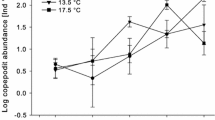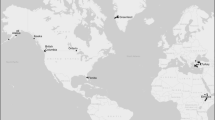Abstract
All metabolic rates of zooplankton are dependent on temperature. Rates generally rise in a linear fashion, with inflection points when plotted on a semi-log scale, and fall at higher temperatures. The upper limits of thermal tolerance for two species of copepods from Chesapeake Bay were found to be near the normal temperature of the habitat during the summer. Acclimation temperature had little effect on the upper limits of thermal tolerance.
Estuarine copepods were killed by passage through the condensers of a power plant, although temperatures encountered were generally below the upper limits of thermal tolerance. Chlorine gas was applied at relatively high rates at that particular power plant and is suspected to be the cause of mortalities. The operation of the power plant did not alter the seasonal patterns of distribution or production of estuarine copepods.
Similar content being viewed by others
Literature Cited
Anraku, M. 1964. Some technical problems encountered in quantitative studies of grazing and predation by marine planktonic copepods.J. Oceanographical Soc. Japan 20:19–29.
Biggs, R. 1968. Biological and geological research on the effects of dredging and spoil disposal in the upper Chesapeake Bay. Final Report—Geology and Hydrography. Univ. of Md., Nat. Res. Inst., Ches. Biol. Lab. Ref. No. 68-2-E.
Burns, Carolyn, andF. H. Rigler. 1967. Comparison of filtering rates ofDaphnia rosea in lake water and in suspensions of yeast.Limnol. Oceanogr. 12:492–502.
Creitz, G. I., andF. A. Richards. 1955. The estimation and characterization of plankton populations by pigment analysis. III. A note on the use of millipore membrane filters in the estimation of plankton pigments.J. Mar. Res. 14:211–216.
Conover, R. J. 1959. Regional and seasonal variation in the respiratory rate of marine copepods.Limnol. Oceanog. 4:259–268.
Cory, R. L. 1967. Epifauna of the Patuxent River estuary, Maryland, for 1963 and 1964.Chesapeake Sci. 8:71–89.
Deevey, G. B. 1960. Relative effects of temperature and food on seasonal variations in length of marine copepods in some eastern American and western European waters.Bull. Bingham Oceanogr. Coll. 17(2):55–86.
— 1966. Seasonal variations in length of copepods in South Pacific New Zealand waters.Aust. J. Mar. Freshwat. Res. 17:155–168.
Heinle, D. R. 1966. Production of a calanoid copepod,Acartia tonsa, in the Patuxent River estuary.Chesapeake Sci. 7: 59–74.
— 1969. Culture of calanoid copepods in synthetic sea water.J. Fish. Res. Bd. Canada 26:150–153.
Herman, S. S., J. A. Mihursky, andA. J. McErlean. 1968. Zooplankton and environmental characteristics of the Patuxent River estuary.Chesapeake Sci. 9:67–82.
Hutchinson, G. E. 1967. A Treatise on Limnology, Vol. II. Introduction to Lake Biology and the Limnoplankton. Wiley and Sons, New York, pp. 490–724.
Marshall, S. M., andA. P. Orr. 1955. The Biology of a Marine Copepod. Oliver and Boyd, London, 188 pp.
McLaren, I. A. 1963. Effects of temperature on growth of zooplankton, and the adaptive value of vertical migration.J. Fish. Res. Bd. Canada 20:685–727.
— 1966. Predicting development rate of copepod eggs.Biol. Bull. 131:457–469.
Mihursky, J. A., andV. S. Kennedy. 1967. Water temperature criteria to protect aquatic life.Am. Fish. Soc. Spec. Publ., No. 4:20–32.
Morgan, R. P., II, andR. G. Stross. 1969. Destruction of phytoplankton in the cooling water supply of a steam electric station.Chesapeake Sci. 10 (3–4): 165–171.
Naylor, E. 1965. Effects of heated effluents upon marine and estuarine organisms, p. 63–103.In Sir F. S. Russell [ed.], Advances in Marine Biology, Vol. 3, Academic Press, London.
Raymont, J. E. G. 1964. The marine fauna of Southampton Water, p. 118–120.In F. J. Monkhouse, [ed.],A Survey of Southampton and its Region, Brit. Ass. Adv. Sci. Southampton.
Raymont, J. E. G., andH. Carrie. 1964. The production of zooplankton in Southampton Water.Int. Rev. ges. Hydrobiol. 49:185–232.
Richards, F. A., withT. G. Thompson. 1952. The estimation and characterization of plankton populations by pigment analysis. II. A spectrophotometric method for the estimation of plankton pigments.J. Mar. Res. 11:156–172.
Siefken, Marie, andK. B. Armitage. 1968. Seasonal variation in metabolism and organic nutrients in threeDiaptomus (Crustacea: Copepoda).Comp. Biochem. Physiol. 24:591–609.
Smyly, W. J. P. 1961. The life cycle of the freshwater copepod,Cyclops leuckarti Claus, in Estwaite water.J. Anim. Ecol. 30:153–169.
Stross, R. G. 1966. Light and temperature requirements for diapause development and release inDaphnia.Ecology 47:368–374.
Stross, R. G., andJ. R. Stottlemeyer 1965. Primary production in the Patuxent River.Chesapeake Sci. 6:125–140.
Author information
Authors and Affiliations
Additional information
Contribution No. 400 from the Natural Resources Institute, University of Maryland.
Rights and permissions
About this article
Cite this article
Heinle, D.R. Temperature and zooplankton. Chesapeake Science 10, 186–209 (1969). https://doi.org/10.2307/1350456
Issue Date:
DOI: https://doi.org/10.2307/1350456




